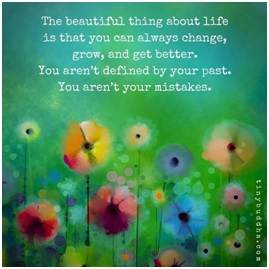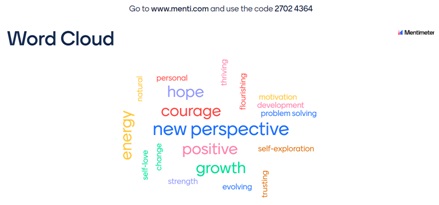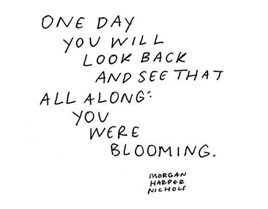A Coaching Model By Anina Knecht, Life Coach, SWITZERLAND
We can all grow, always…

Growth (meaning)
“the act or process, or a manner of growing, developing, or gradual increase”
“stage of development”
“development from a simpler to a more complex stage”
“development from another but related form or stage”
“something that has grown or developed by or as if by a natural process”
We all get multiple chances to change, grow and get better each day of our life. That does not mean we have to turn our life upside down, become a new person, or make a ground-breaking invention. It is those small everyday life experiences like having snapped at our partner while actually being frustrated with ourselves, being distracted or multi-tasking during an important conversation with a team member at work or our child, or simply giving the negative self-talk more space that we want to. In each of these situations, it is our choice whether to stand still by continuing with the same patterns or to choose to learn from it, reflect upon it, and maybe, just maybe, try something different next time. – This is growth.
During my research I have come across this old Chinese proverb, which I find very fitting:
Be not afraid of growing slowly; be afraid only of standing still. Chinese Proverb
No matter how small or insignificant our steps may seem; it’s still a step, and it’s still growth.
Explanation of the Growth Coaching Model
The four elements of this model are Individuality, Mindset, Perspective, Action & Accountability.
 This coaching model shows the growth of the client as a whole, represented by the pictogram of the flower. Its foundation consists of the client’s individuality, their roots, and who they are as a person, as well as their mindset and the views they hold, they are mentally nourishing. During the session, the client has space to be creative and to explore both and is invited by the coach to find a different angle to the same, which often is a more positive perspective that serves the client better and supports them to overcome a specific obstacle. With this shift in perspective, the client can step into action and finding means to hold themselves accountable for the actions they have defined. With that, growth has happened – much like a flower opening up to the warming sun.
This coaching model shows the growth of the client as a whole, represented by the pictogram of the flower. Its foundation consists of the client’s individuality, their roots, and who they are as a person, as well as their mindset and the views they hold, they are mentally nourishing. During the session, the client has space to be creative and to explore both and is invited by the coach to find a different angle to the same, which often is a more positive perspective that serves the client better and supports them to overcome a specific obstacle. With this shift in perspective, the client can step into action and finding means to hold themselves accountable for the actions they have defined. With that, growth has happened – much like a flower opening up to the warming sun.
The flower as a whole represents the client, and the shining sun, in this case, the coaching, leads the way and holds a trusted space for the flower, our client, to grow.
Let’s look at the individual elements in more detail.
Elements of the Growth Coaching Model
Individuality
- Who are you?
- What do you stand for?
- What makes you unique?
Wikipedia defines individuality (or self-hood) as the state or quality of being an individual; particularly of being a person unique from other people and possessing one’s own needs or goals, rights and responsibilities.
Every person is unique. We think differently, we act differently, we have different perspectives, we have different values and we have different beliefs. We are all different. If we think about the number of people on the planet, over 7.5 billion, then that is a whole lot of variety. We all have our own character and have been influenced by our environment, which leads to a unique set of knowledge that we store and experiences that we make, and ultimately has led us to live very different lives. All of this we bring to coaching as clients and it is the coach’s responsibility to embrace this uniqueness and create a safe space for each client.
Mindset
- How do you see the world?
- What do you believe in?
- What are your values?
- What do you stand for?
- How are your actions aligned to your way of thinking?
Because we are all unique as a person and conditioned by our upbringing and the environment we live in, we view the world through our very own lenses. I really like this saying, which for me puts it in a nutshell:
We do not see things as they are. We see them as we are. – Talmud
As coaches our responsibility is to focus on the client as they truly are – their unique internal way of being including their mindset – their values and beliefs. It is easy to fall into the trap of only seeing external circumstances and solutions, that are usually concrete and seem “safer” to deal with (need for a to-do list and calendar system to manage time, getting more exposure to get promoted, empower team members to be a good leader, etc.) True growth however results from coaching the person to find individual internal solutions by coaching the “WHO” (client’s mindset) and not the “WAT” (problem, goal). It is not possible to coach the WHAT without the WHO behind it.
What is value?
- the regard that something is held to deserve; the importance, worth, or usefulness of something.
- principles or standards of behavior; one’s judgment of what is important in life.
It is what is driving us, and our behaviors based on experience even since childhood, our perception, and our own reality which forms our inner compass. Our mindset is not observable and to a larger extent part of our subconscious, but it results in our actions which are. As coaches, we are exploring the outer and inner values of our clients, their belief systems, outside pressure and influence that drive them, and inner commitment. Our role is not to determine what values & beliefs are best for our clients but to assist them in aligning their mindset with their pathway forward. Usually, the client’s use of language provides insight into their mindset, how committed they are to something, and also to what extent their language supports their success and not their failure.
To change our mindset, we first have to become aware of it, challenge ourselves, and be open to what we discover without holding judgment. Why do we even look at our mindset, our values & beliefs? We do so to create awareness about who we are and what we do, understand ourselves better, understand where beliefs are coming from, and if they don’t serve us, take ownership to change them. If you are curious about your own mindset and what values & beliefs you are holding, try this exercise: “I can’t do X because of Y”. Y may give you a clue to your own limiting values & beliefs.
Perspective
- What would be a different view?
- What (if something) else might be true?
- What do you want right now?
- What is the best thing that could happen here?
Because we all have our very own point of view, we consciously or unconsciously give significance to our experiences and emotions. Awareness of what we are giving meaning to is the catalyst for replacing values, beliefs, and perspectives that don’t serve us, that stop and restrain us rather than support us to overcome a specific obstacle, to let us thrive and grow. Finding a new perspective supports clients to view things differently and, as a result, find new, often more empowering ways of looking at a certain situation. Usually, when clients come to a coaching session it is not the specific situation they bring or their life circumstances that is the problem, it is the perspective they hold towards that situation. While it is not always possible to change the circumstances, we can choose to change our perspective at any time.
The key moment in every coaching session for me is when this moment of clarity comes and a shift in perspective is possible. I have explored this further in my Power Tool “Perspectives vs. Heaviness”.
And if you are interested in what’s happening in the brain from a neurophysiological point of view when we shift perspectives or change behaviors, I recommend reading my research paper “A Neurophysiological Approach to Change in Perspective”.
Action & Accountability
- What needs to happen now?
- What does action look like for you?
- What is telling you that this is the right step to take?
- How can you enable yourself to meet your actions?
- What can help you to stick to your actions?
Once through the challenging of client’s perspectives, the moment of awareness and acceptance has come and a shift in that perspective has happened, the client can describe their learning and create actions for the future to not being stuck in the same situation over and over again. Creating action is not always easy. However, it is critical to our feeling of success and achievement. Action is doing. Action is an opportunity for us to experience something new. Actions are like the proposal for what steps to take next. When actions are doable and aligned with the client’s values & beliefs, they are empowering and can create confidence, which creates action in return.
Last but by no means least, accountability manifests and solidifies that action, so that growth becomes possible. ICA defines accountability as the ability to show or tell (give an account of) how someone is meeting their responsibilities. This is the state of demonstrating that a person’s knowledge, thinking, actions, and being are aligned with their responsibilities.
Assisting clients to take ownership of their lives and to move forward towards their dreams requires that the clients take responsibility for all of their choices, decisions, and actions. Holding themselves accountable for these outcomes is key. As coaches we support clients to hold themselves accountable throughout the coaching process but specifically within the action planning stages by helping them to examine their inner motivation to follow through, their state of ownership and what they believe they can control, as well as how they can acknowledge themselves for the work they have done and building resilience for the next big step.
True growth happens when people find internal solutions, not just change their outer circumstances. Internal changes in a client’s mindset move the client forward. The result may be longer-term growth that goes beyond the specific problem or goal at hand that the client brought to a coaching session.
Coming back to the old Chinese Proverb, the choice is to either never know and stand still or to take the action and to, slowly but surely, grow and blossom like a beautiful flower.
The coach’s approach with the Growth Coaching Model
Associations with the Growth Coaching Model
I have surveyed with peer coaches, friends, and family and these are the top associations of people with the Growth Coaching Model:
Practice
The Growth Coaching Model has been tested in practice and has worked for me both as a structure to coach, as well as for being a client. It can be used either within each coaching session or a series of coaching sessions that work towards a specific goal. The model as well as the associations my surrounding has with it resonates with me and also sits well with my coaching niche in Life Coaching as a Personal Development Coach, working with individuals.
I would like to leave you with that thought …
References
Illustrations and pictogram by Gabriella Knecht https://www.gk-illustration.ch/fine-art/– © by Gabriella Knecht – All rights reserved.
https://www.goodreads.com/quotes/8715798-be-not-afraid-of-going-slowly-be-afraid-only-of
https://www.dictionary.com/browse/growth
https://en.wikipedia.org/wiki/Individual
https://learnsite.icacoach.com/english-campus/coach-skills-course/
https://keithwebb.com/how-to-coach-the-person-not-the-problem/
https://archive.coachcampus.com/articles/sample-module/
https://www.google.com/search?
https://docs.google.com/document/
https://docs.google.com/document/d/
https://archive.coachcampus.com/cp/5-coaching-skills-ebook/taking-action/
https://docs.google.com/document/d/1
https://docs.google.com/document/d/11
https://morganharpernichols.com/